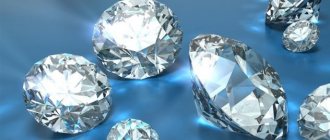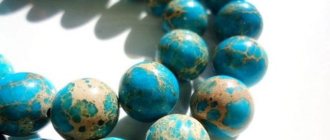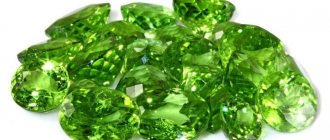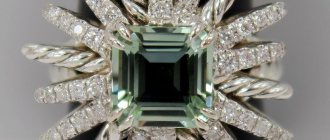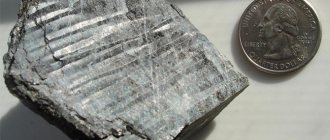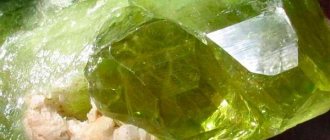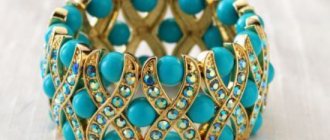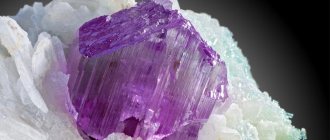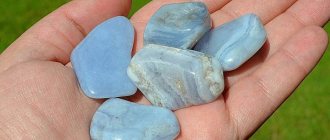There are many secrets, misconceptions and superstitions in the history of pearls. Today we will dispel some myths and share interesting facts about this amazing gift of the sea.
Origin of pearl beads
Pearls are not stones at all, even though they call them that. It owes its appearance to sea and freshwater mollusks, because pearls are formed inside their shells.
The appearance of a pearl is facilitated by the ingress of various debris into the mollusk - from dust particles to microscopic inhabitants of the seabed. The mollusk perceives any foreign body as a potential danger. To avoid possible injury, it begins to secrete a special substance - mother of pearl.
“Perlmutter” is translated from German as “mother of pearls.” By the way, not only the contents of the shell, but also the shell itself can be mother-of-pearl. The inside of the shells of some mollusks is also covered with mother-of-pearl.
It envelops the “alien”, smoothing out all the sharp corners. This is how a pearl is formed. The release of a protective substance does not stop as long as the irritant is in the sink. This usually happens when a shell containing a pearl falls into the hands of a treasure hunter, a professionally trained diver.
Diseases and pests
The Pink Pearl tomato variety is resistant to most diseases. When planted in open ground in the second half of summer, a tomato may develop late blight. To avoid problems, plants are regularly inspected, fruit-bearing shoots are cut off, and sprayed with a phytosporin solution.
If the disease manifests itself in the form of curled or blackened leaves, the bushes are sanitized and the affected branches are removed. Copper sulfate, Bordeaux mixture and fungicides are used for control.
Tomatoes are rarely affected by pests. Among the most common are whiteflies and spider mites. Most often they appear in greenhouses. They are fought with chemicals.
Where and how is it mined?
Nowadays, natural pearls are considered a luxury. But this does not mean that most of the jewelry in stores is fake. Massive mining of this mineral in the last century has led to the fact that natural reserves of “sea tears” have become very scarce.
There are a huge number of pearl farms around the world.
Therefore, the bulk of the goods that fall into the hands of jewelers come from artificial plantations created by man. Mikimoto Kokichi was the first to organize such a plantation. The products themselves, obtained by growing on farms, are called cultivated.
The magical properties of such pearls are questionable. On the one hand, this is not an artificial product, because mollusks themselves produce pearls. On the other hand, these stones will not be able to completely absorb the life-giving energy of nature.
Pearl extraction is carried out as follows. The space allocated for the farm is populated with mollusks of a certain age. Usually these are shells from 2-3 years old. Carefully opening them, divers add a piece of garbage to them, and then the mollusks themselves do everything.
Of course, all this is conditional. The cultivation of pearls is under strict control, although experts try not to interfere too much with the natural process. After a few years, the beads are removed and sent for sale (although some samples can be kept inside for a dozen years or even more).
The growth rate of the “droplet” depends on the type of pearl oyster and the water (salty or fresh). Sea shells produce large beads, but river shells are considered more fertile - several pearls can ripen inside them at the same time.
If we talk about natural deposits, production is mainly carried out in the waters of Japan and Sri Lanka. Freshwater pearls are actively mined in Russia, China and North America.
Gold and white
Stones with a muted shine are called golden and are mined on the coasts of Indonesia and Australia. Sizes are up to 1 cm. The center where black pearls are concentrated is Tahiti. This extraordinary jewel is worthy of kings. The sizes are larger (1.5-1.8 cm), shades are blue, purple, green.
Silver-lipped mollusks produce white pearls up to 2 cm in diameter. These creatures are capricious, so every specimen that comes from them is considered exclusive. The Philippines and Australia specialize in cultivation.
Since the pearl is formed naturally during cultivation, the resulting specimens cannot be called artificial. However, from the 15th century there were already imitations. These are the famous Roman balls. Hollow inside, they were made of ordinary glass and filled with paraffin. Mother-of-pearl essence made from fish scales has also become widespread for coating the surfaces of fakes.
Physical and chemical properties
Pearl is an organic mineral. This distinguishes it from gemstones that are mined from the earth. In fact, “tears of the sea” are a product of a mollusk’s protective reaction to an external irritant entering the shell.
Its physical and chemical properties:
- formula - CaCO3;
- hardness - 3-4 on the Mohs scale;
- shine - pearlescent;
- fracture - shell-like;
- transparency - opaque, translucent;
- color - white, silver, gold, cream, pink, brown, blue, green, gray, black;
- density - 2.60-2.78 g/cm³;
- refractive index - 1.52-1.66 (for black - 1.53-1.69);
Pearls come in a variety of colors: white, silver, gold, cream, pink, brown, blue, green, gray and even black. Experts counted more than a hundred shades. The color is influenced not only by the type of mollusk-producers, but also by location and age.
What determines the color of pearls
The tonality of a stone is determined by three factors:
- main tone - the predominant color;
- additional (overtone) - a less intense shade that is visible when light falls on the surface;
- reflection - a glow coming from the depths.
An additional tone can play and shimmer in several shades, but the main tone will always be much richer. This is how the color is determined.
The color of pearls is influenced by several factors. First of all, this is the type of oyster and the color of its mantle, as well as the habitat or location of the farm where the cultivation takes place. The temperature of fresh or sea water and its composition are important.
Due to the manganese content in the water, pearls grown in India are pink in color. Blue and green stones are from Indonesia. Minerals of gold and brown tones are characteristic of Mexico, and white - of Japan. Farms that cultivate pearl beads usually add special substances to the water to obtain the desired shade.
The color of minerals that have bumps may be or appear uneven (the depressions are slightly darker). In this case, a more careful analysis is needed.
Types of pearls
Many people associate sea stone with white, but nature has also given it other shades. There is a whole classification, according to which each species has its own name.
Here are some of them:
- Mabe - stones of gray, silver or black shades.
- Kasumi is a cultured stone originally from Japan. It is a mixture of gold, purple, and green shades.
- Tahiti - Like mabe, Tahitian stones are eggplant-colored beads with gray and silver tints.
- South Sea. Minerals of this type are distinguished by a rich golden color.
- Baroque - most often it is a white stone, but sometimes cream-colored specimens are found.
- Akoya are pebbles formed inside sea mollusks. They have a variety of colors - from white to green-black.
- Keshi. Quite an unusual type of sea stone. It has a silvery-white color and can be recognized by its appearance. It usually looks somewhat flattened.
Pearls also come without nacre. This type is called conk. It looks like porcelain pebbles in soft pink shades.
In fact, there are a lot of classifications. Other groups sort stones by weight, presence or absence of mother-of-pearl, luster, and shape.
Colors and varieties
In the minds of most people, pearls are white or milky shiny balls. In fact, there are many varieties of it. Pearls of the following colors are found in nature:
- White is a classic option.
- Lactic.
- Cream.
- Pink.
- Silver.
- Black.
- Light and dark green.
- Blue.
- Other shades.
The following types of natural pearls, grown by mollusks without human intervention, are known all over the world:
- River. Pearls have a diameter of no more than 7 mm, spherical or elliptical in shape, white, gray, yellowish or cream in color.
Freshwater pearls 5 mm
- Oceanic. Pearls are always large in size, grown by mollusks that live in warm bays of the oceans. Colors can be different - white, milky, silver, cream, pink and green-black.
Ocean pearl
- Freshwater. Pearls develop in the shells of mollusks that live in fresh water. Moreover, their number in one sink can reach from 5 to 25 pieces, hence the lower cost of this type. Pearls are usually small in size and round in shape, silvery white or milky in color.
Freshwater pearls
- "King". This is the name given to very large pearls (up to 22 mm) of the highest quality (they have a thick layer of nacre), grown only in the South Seas.
Pearl "King"
- "Mabe." Blister pearls have a hemispherical shape, obtained as a result of the characteristics of cultivation. Such pearls do not grow in the mantle of the mollusk, but on the valve of the shell. Colors include silver, smoke, metallic grey, dark green and shiny black.
Pearls Mabe
- "Baroque". Pearls got their name from their irregular shape (translated as “bizarre”). This also includes varieties of “monsters” and “paragons”, shaped like figures of animals and people. This type of pearl is quite inexpensive, since “fancy” pearls are considered defective jewelry, although talented craftsmen create amazing jewelry from them.
Baroque Pearl
Certain varieties of pearls can grow either independently in nature or be cultivated by humans. These include baroque, freshwater and other types.
Among the cultivated varieties, the most popular are:
- "South Sea". The most expensive pearl in its group. It comes in white, silver and gold. It has the thickest pearlescent layer. Always large and high quality.
- "Tahiti". Round pearls of medium and large size (up to 12 mm), grown near the Polynesian islands. The colors are predominantly dark - from silver-gray to black.
- "Akoya." Medium-sized pearls (up to 14 mm), grown in sea water. The color range is varied, only blue ones are not found.
- "Kasumi." An exotic Japanese variety that can have any color, including gold and purple.
The most famous artificial variety is the Mallorca pearl. It is produced in a Spanish factory located on the island of the same name. The growing process is the same as in nature, but shellfish are not involved in it. A special technology allows you to create a perfectly round pearl in just one month.
Pearls of Mallorca
In terms of aesthetic and other properties, Mallorca pearls are not inferior to natural and cultured pearls, but are much cheaper. They have practically no magical or healing properties.
Interesting Facts
Despite prejudices and superstitions, many brides choose pearls as decoration.
Pearls are a mysterious and mysterious stone. There are many legends, signs, and prejudices associated with him:
- Our Slavic ancestors believed that this was a good wedding gift. The groom gave pearl jewelry to his beloved so that their life together would be happy.
- In some European countries, there is a tradition of tying newlyweds with mother-of-pearl beads right at the wedding. There is a sign associated with it that helps to understand whether the newlyweds will be together. A broken thread promised tears and a break in relationships.
- Nowadays people believe that wearing pearls to a wedding is a bad omen. Supposedly this leads to tears. Apparently, this superstition was facilitated by the fact that pearls were previously called “tears of the sea.”
- Women love jewelry and often receive pearls for their birthdays. Experts are still arguing about this. Some believe that it is not worth giving it for a birthday, so as not to doom your loved one to misfortune, while others say that a better symbol of happiness cannot be found.
- The stone is often recommended to be worn in pairs. It helps maintain harmony in relationships, smooth out misunderstandings, and dispel negative energy in the home. But there is a danger here - the talisman can reduce sexual attraction to a partner, so it is better not to abuse it.
Reviews of tomatoes Zhemchuzhina pink
Olga, 28 years old, Belgorod The Garden Pink Pearl tomato variety appeared on my balcony last year. A colleague had a few bushes left. There were three bushes. All fruited well. There is only one point. It requires wide containers. Otherwise, the creeping branches hang from the flowerpot and break under the weight of the fruit. And it’s both delicious and beautiful.
Daria, 45 years old, Balabanovo I always plant cherry tomatoes. At least a few pieces. And there was always something that didn’t suit me. The Pink Pearl tomato turned out to be a godsend. Compact plants bore fruit from the end of June until almost frost in the open air. The harvest was excellent. The bright jars made me happy all winter.
Areas of use
The main application is jewelry making. Craftsmen fell in love with sea pearls for their friendliness and beauty. There are many shades in nature, so it can be combined with almost any metal or gem.
Mother-of-pearl pearls are widely used among jewelers.
Fashion, which is closely interconnected with jewelry, also got along with pearls. In the Middle Ages, they decorated the clothes of noble people, decorated dishes and interior items with sea drops. Often among antique items you can find icons embroidered with mother-of-pearl beads.
Jewelry with pearls is not only an accessory, but also a talisman. The stone emits healing energy, so it will primarily be useful to those who are often sick. And for people in need of peace, it will help restore balance in life.
Today this tradition has not been forgotten, although such pleasure is not available to many. Ordinary people usually decorate holy images with beads or beads that imitate the appearance of real mother of pearl.
Price
The cost of pearls depends on the following parameters:
- size;
- colors;
- shine;
- surface cleanliness (no defects);
- origin;
- forms.
The most valuable are spherical pearls with a thick mother-of-pearl layer, a smooth surface, and a bright shine.
Pear-shaped and oval-shaped specimens are less valued by jewelers.
There are connoisseurs of “baroque” (irregularly shaped) and “paragon” pearls (reminiscent of figures of people, animals, and plants).
The cost of sea pearls is usually 5–6 times higher than river pearls , since the latter are on average smaller and less often have a regular spherical shape.
Cultured pearls are usually cheaper than natural pearls, although they are not artificial. But some of its specimens are valued higher than those generated by nature.
Color plays an important role in the evaluation of this stone. The highest cost is for “wild” specimens of the following colors:
- black;
- deep blue;
- white without the slightest tint.
Moreover, these pearls should be large (from 10 mm in diameter) and perfectly round in shape.
Yellow copies have the lowest price.
10 mm in diameter , can be bought for $380–400 , and equivalent in quality, 15 mm in size, for $1,500 , since such large specimens are rare.
Examples of prices for pearl products that can be purchased in Russian online stores:
- bracelet made of pink pearls - 711 rub. ;
- small river pearl beads, white (45 cm) - 712 RUR. ;
- bracelet made of cultured pearls - 1180 rub. ;
- beads made of white cultured pearls (43 cm) - RUB 2,470.
How to distinguish real pearls
Pearls are popular, so they are often counterfeited. Counterfeits can be purchased not only where prices are low, but also in luxury stores. For this reason, it is better not to lose vigilance.
How to spot a fake:
- Check the pearls for teeth. If you run your teeth over the surface, it should make a slight squeak. However, if it is still a fake, paint may remain on your teeth. Then you will have to pay for damage to property.
- When checking the tooth, scratches may appear. If you only notice teeth marks and no cracked paint, it's most likely real stone.
- Pay attention to the weight. Natural stone is much heavier than imitation pearls.
- Take a closer look at the surface. Natural pearls, extracted from mollusk shells, have irregularities that resemble wrinkles. Their complete absence immediately reveals imitation. Artificial pearls are smooth, like a Christmas ball.
- Pay attention to the hole. This applies to beads and bracelets. Looking closely at the place where the thread passes, you can see how the layer of paint near it has cracked. If there is nothing like that, then there is nothing to worry about.
Unfortunately, the most reliable authenticity tests are the riskiest. No one will let you taste the stone, so you will have to be content with inspection. If you are not at all sure that you will not make a mistake, call a specialist. An experienced jeweler will immediately figure out where the stone is real and where it is fake.
Description of the tomato Pink Pearl
More recently, the cultivation of pink varieties of tomatoes was the lot of residents of the southern regions. Today, breeders introduce new species almost every year. The Pink Pearl tomato variety is cherry tomatoes, which are distinguished by the delicate color of the fruit, their density and fleshiness. And also extremely unpretentious in care.
The variety can be grown throughout the country. Breeders recommend growing tomatoes in open ground or in containers on a balcony or veranda. However, judging by the reviews, the Pink Garden Pearl tomato develops well and bears fruit in greenhouses and film shelters. You just need to choose the right place for it and not plant it next to tall, spreading tomato varieties.
The Pink Pearl tomato, described in the article, is a low-growing determinate plant. Its height is only 30-40 cm. It forms creeping shoots covered with simple green leaves. The bush does not need to be formed or provided with supports. Forms yellow inflorescences collected in brushes of 8-10 pieces.
The attractive appearance of tomatoes makes the Pink Pearl variety a favorite of many cherry fans. The fruits are smooth, round or rounded-elongated. Cherry weight – 15-20 grams. The skin is a delicate pink color with a slight glossy sheen. The number of sections with seeds reaches three, which does not prevent the tomatoes from remaining dense and fleshy, but adds juiciness. Cherry has an excellent taste, with pronounced sweet notes and a delicate aroma.
Interesting fact! Tomatoes of the Garden Pink Pearl variety contain the substance lycopene, which destroys fatty tissue and, together with its low calorie content, makes the variety indispensable for weight loss. The excellent taste of tomatoes will help you stay on track when following a diet.
The Pink Pearl tomato is an unpretentious crop that does not require special attention other than standard procedures: watering, fertilizing and harvesting. The only thing that needs to be provided for a low-growing plant is access to light.
How to care for pearls
If you wear pearls with proper care, your jewelry will serve you for a very long time. They can even be passed on by inheritance, although esotericists do not welcome these actions. It is believed that the sea talisman absorbs the owner’s negativity and then passes it on to the next owner.
Care instructions:
- Jewelry should be stored separately from other jewelry. The mineral is very fragile, so try to protect it from falls and impacts with other talismans.
- The stone does not like heat and is afraid of high temperatures. Not only the sun, but also the artificial warm climate recreated indoors. So it’s better not to go to the bathhouse with him.
- By the way, cold and humidity can also harm the amulet. Being in such conditions results in a loss of shine for him.
- This is tricky stuff. It is not only fragile, but also does not like to interact with various substances. Perfume, foundation and hairspray can ruin it. Try to prevent jewelry from coming into contact with cosmetics.
To keep your jewelry beautiful, pearls need to be cleaned. Professionals use a weak solution of acetic acid for this. But if you are afraid to take the wrong proportions, you can replace it with a safer soap solution.
History and origin
Even in pre-biblical times, the beauty of pearls was associated with heavenly purity and high status. The first mention of a necklace with sea gems, which belonged to the king of Mesopotamia, dates back to the 40th century BC. The myths of Ancient Greece tell: Aphrodite, born in sea foam, shook off her hair as she emerged from the water. The drops scattered, turning into oval crystals glowing with a rainbow radiance.
In India, snow-white beads and tiaras were worn on brides of noble origin, embroidered with them on the turbans of the Maharaja, and presented to temple goddesses. The Chinese emperor's cap was crowned with 12 white balls. Only members of his family and chief advisers were allowed to wear pearl jewelry, who attached mother-of-pearl brooches of distinction to silk scarves.
Pearls were considered a rare treasure in Egypt. The magical rejuvenating properties of sea stone were known to Cleopatra: in an arid climate, the powdered mineral added to the cream retained life-giving moisture and filled the skin with radiance.
Having argued with the lover Mark Antony whose dinner would be more luxurious, Cleopatra, in contrast to the abundant Roman feast, presented simple dishes, but dissolved a five-centimeter golden pearl in wine, equal in price to an entire British province, and won the argument. Long earrings made of heavy gemstones reminiscent of a woman’s breasts enhanced the attractiveness of Egyptian women and popularized seafood in Rome. They decorated the temples of Venus, Jupiter, Asclepius, decorated the clothes of the children of high-born patricians and presented them as a sign of love to beauties.
European nobles of the 14th-16th centuries adored the mother-of-pearl mineral and forbade other classes of society from wearing pearls under pain of punishment. Jewelers strung it on threads, creating multi-layered beads and bracelets, and seamstresses embroidered dresses with white sparkles. Portraits of the 15th-16th centuries indicate that Mary Stuart, Diana de Poitiers, Catherine de Medici, Elizabeth I wore snow-white necklaces as everyday jewelry, emphasizing the beauty of their hair and the fabric of their dresses.
The kokoshniks of Slavic princesses were covered with layers of river stones mined in the cold waters of the Dvina, Ladoga, Volga and Onega. The wedding dresses of future spouses were hand-embroidered by unmarried girls. Blue minerals with an icy shine protected against the evil eye and strengthened the purity of feelings. The 18th century brought fashion for round sea gems, but freshwater ones were also imported. The right to production was bought by monasteries, who earned millions from its sale.
Coco Chanel immortalized the elegance of the noble beauty of pearls. In combination with the little black dress, it became a symbol of the upper class, regardless of the origin of a person who felt worthy of royal chic.
RELEVANT: Jadeite is a stone that brings good luck
Healing and magical properties
Pearls are loved for their beauty. Women loved the simplicity and elegance of this seafood so much that jewelry made from it became a cult. But many ladies do not know that their favorite jewelry has unusual properties.
Pearl jewelry has a positive effect on the nervous system.
But in the past, people remembered the healing and magical properties of the sea talisman. It is known that not only stones, but also powder from them were used.
This powder was the main ingredient in medicinal tinctures used to treat eye diseases. This remedy also helped stop bleeding.
Useful properties of pearls:
- calms the nerves;
- pacifies headaches - it acts not on external factors, but on the root causes;
- helps cure liver and kidney diseases;
- restores memory to its former flexibility;
- relieves sudden surges in pressure;
Pearl products exhibit their magical qualities best in women's hands. They help women prolong their youth, allowing them to sparkle with beauty for much longer. Sea “droplets” also add charm and wisdom to their owner.
Another interesting property of mother-of-pearl beads is their ability to warn of danger. A suddenly faded talisman indicates that trouble is approaching. But he won’t tell you what kind of troubles are coming, so remain attentive in order to notice in time where you took a wrong turn.
Healing properties
Sea pearl oyster
The medicinal properties of pearls are associated, firstly, with its ability to diagnose the body, and secondly, with the ability to restore problem areas in organs associated with the removal of excess fluid from the body and the digestive tract. Pearls are suitable for those who suffer from stomach diseases associated with changes in acidity, and also have problems with the kidneys and liver, and to a lesser extent, with the intestines.
The diagnostic properties of pearls are due to the fact that they change their color if the acidity of the upper layers of the skin changes in the owner. This in itself indicates unfavorable processes that have begun in the body. Some lithotherapists believe that if a pearl fades, loses its shine and becomes cloudy, this means the emergence of a tumor process in the body (mainly in the abdominal organs). Thus, mother of pearl signals when it is time to see a doctor to check the whole body. To some extent, it is able to “slow down” the development of the disease.
People suffering from conjunctivitis and other eye diseases associated with constant discharge from the eyes can wear pearls. It will help reduce the amount of discharge.
Who is suitable according to their zodiac sign?
There is no need to be afraid of confusion with astrological compatibility. The stone was discovered a long time ago, and astrology did not appear today. This means that experts had a lot of time to study the influence of the stone on the zodiac signs.
Who is it suitable for:
- Cancer and Pisces. Pearls and these zodiac signs belong to the same element - water. But don't be fooled. This harmonious union can also cause harm. Too frequent contact with the talisman will turn Cancers and Pisces into hypersensitive individuals.
- Taurus . But with this sign it’s the other way around. The stone will quickly pacify the restive temperament of the stubborn Taurus and teach him to get along with loved ones.
- Aquarius . This sign will also receive its portion of peace from the sea amulet.
There are also signs for whom the stone is not suitable at all. The first candidate for incompatibility is Leo . All because the elements of fire and the elements of water are at enmity with each other, oppressing each other. Therefore, the king of beasts cannot expect any benefit from the water talisman. If Leo begins to wear this stone often, his usual successes in his career will quickly turn into failures. for Sagittarius and Aries for the same reason. Gemini and Capricorn not to buy items with pearls .
Compatibility with other stones
Pearls belong to the element of Water, so they go well with other “water” gems:
- moonstone;
- opal;
- emerald;
- alexandrite;
- aquamarine.
Although usually the stones of Water and Earth are energetically compatible, it is believed that pearls do not like to coexist with stones of the Earth element, especially cacholong, jasper, chalcedony, and morion.
Partnership with Air stones (except sapphire) is allowed: uvarovite, amethyst, topaz, chrysoprase, hyacinth, smoky quartz.
Pearls cannot stand proximity to “fire” stones, especially with:
- diamond;
- ruby;
- pomegranates (including greenish grossular).
Caring for your jewelry
Organic origin makes it mandatory to have a reverent attitude towards pearls. Time is inexorable to him, just as it is to a person - an aging pearl loses its beauty, loses its luster, dries, flakes.
Stones are contraindicated:
- increased humidity or dryness;
- contact with human sweat;
- interaction with cosmetics, household chemicals, fat.
When cared for, a gemstone can last up to two centuries.
Place of Birth
Except for jewelers and gemologists, stone miners know everything about pearls. This profession is traditional for warm countries washed by the sea or ocean.
The place of extraction is what determines the color of the pearl:
- white – Australia, Japan;
- yellow – Red Sea, Persian Gulf, Sri Lanka;
- gold – Panama;
- red – Mexico;
- pink – India, USA (California), Bahamas;
- silver – Australia;
- gray – Tahiti island.
The colors of freshwater pearls vary. It is found in Russia, the USA, China, and Germany.
The largest is the “Pearl of Allah” weighing 6.5 kg. It is oblong, 24x16 cm, found in a 300-kilogram mollusk.
